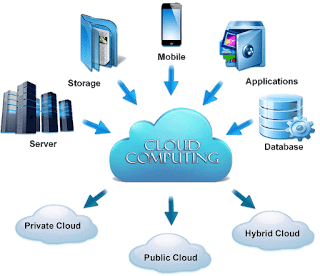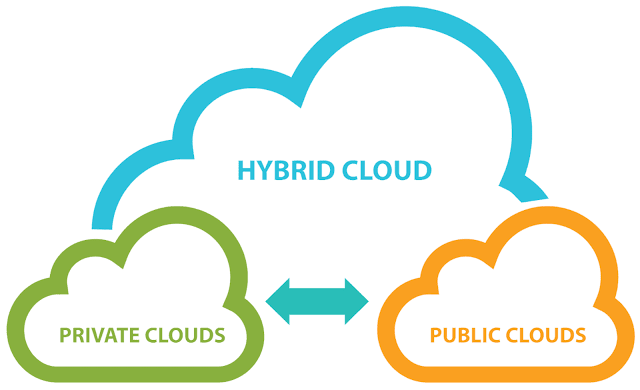Hybrid Cloud the Future of Computing
January 08, 2018
For several years, cloud computing has been the focus of IT decision makers and corporate bean counters, but many security-conscious businesses have been hesitant to move data and workloads into the cloud. As cloud computing continues to generate a huge amount of buzz and interest over its future, another phenomenon is gaining investor’s and developer’s interest with promises to upend the future of enterprise IT. Hybrid cloud tech, which has only recently come into its own, is increasingly being recognized as the cash-cow of the future.
What is Hybrid Cloud?
A hybrid cloud is a computing environment which combines a public cloud and a private cloud by allowing data and applications to be shared between them. When computing and processing demand fluctuates, hybrid cloud computing gives businesses the ability to seamlessly scale their on-premises infrastructure up to the public cloud to handle any overflow - without giving third-party data centers access to the entirety of their data. Organizations gain the flexibility and computing power of the public cloud for basic and non-sensitive computing tasks, while keeping business-critical applications and data on-premises, safely behind a company firewall.
Benefits
Security – including private cloud in the mix gives reassurance when it comes to security of your most sensitive operations, and can make it easier to meet regulatory data handling and storage requirements.
Cost efficiency – depending on your use, public cloud tends to offer a more cost-effective solution than private cloud. Hybrid cloud adopters can balance their need to be cost efficient with the security of keeping their most sensitive and critical workloads on private cloud.
Scalability – private cloud is not necessarily un-scalable but public cloud will always be able to offer more in this regard. By moving those workloads that most benefit from scalability to the public cloud, you also reduce the demands on your private cloud.

Flexibility – the “pick and mix” style of hybrid cloud gives organizations the chance to explore a variety of operational directions and find the optimum cloud solution for them.
Preservation of investments – a hybrid cloud strategy enables you to continue using existing IT investments, whether on premises or colocated.
Difference between private, public and hybrid cloud?
Private Cloud: the cloud services used by a single organization, which are not exposed to the public. A private cloud resides inside the organization and must be behind a firewall, so only the organization has access to it and can manage it.
Public Cloud: the cloud services are exposed to the public and can be used by anyone. Virtualization is typically used to build the cloud services that are offered to the public. Example for public cloud are Amazon Elastic Compute Cloud (EC2), IBM’s Blue Cloud, Sun Cloud, Google App Engine and Windows Azure Services Platform.
Hybrid Cloud: the cloud services can be distributed among public and private clouds, where sensitive applications are kept inside the organization’s network (by using a private cloud), whereas other services can be hosted outside the organization’s network (by using a public cloud). Users can them interchangeably use private as well as public cloud services in every day operations.
| Difference | Private | Public | Hybrid |
Data Center Location
|
Inside the organization’s network.
|
Anywhere on the Internet where the cloud service provider’s services are located.
|
Inside organizations network for private cloud services as well as anywhere on the Internet for public cloud services.
|
Tenancy
|
Single tenancy: there’s only the data of a single organization stored in the cloud.
|
Multi-tenancy: the data of multiple organizations in stored in a shared environment
|
The data stored in the public cloud is usually multi-tenant, which means the data from multiple organizations is stored in a shared environment. The data stored in private cloud is kept private by the organization.
|
Cloud Service Management
|
The organization must have their own administrators managing their private cloud services.
|
The cloud service provider manages the services, where the organization merely uses them.
|
The organization itself must manage the private cloud, while the public cloud is managed by the Cloud service providers(CSP).
|
Exposed to the Public
|
No: only the organization itself can use the private cloud services.
|
Yes: anyone can use the public cloud services.
|
The services running on a private cloud can be accessed only the organization’s users, while the services running on public cloud can be accessed by anyone.
|
Hardware Components
|
Must be provided by the organization itself, which has to buy physical servers to build the private cloud on.
|
The CSP provides all the hardware and ensures it’s working at all times.
|
The organization must provide hardware for the private cloud, while the hardware of CSP is used for public cloud services.
|
Expenses
|
Can be quite expensive, since the hardware, applications and network have to be provided and managed by the organization itself.
|
The CSP has to provide the hardware, set-up the application and provide the network accessibility according to the Service Level Agreement(SLA).
|
The private cloud services must be provided by the organization, including the hardware, applications and network, while the CSP manages the public cloud services.
|
Drawbacks
Although the benefits outweigh the negatives in most cases, building a hybrid cloud poses a number of challenges, and for this reason, it may not be the solution for every company hybrid cloud can present technical, business and management challenges. Private cloud workloads must access and interact with public cloud providers, so hybrid cloud requires API compatibility and solid network connectivity.
Cost:In case of an outage, the organization has to rely on the internal IT for any support to handle the outages in the hybrid environment. One of the ways to reduce it would be to create redundancy across its data centers. In order to mitigate the risks, the company may have to use multiple cloud services.
Security : Cloud computing is not inherently any less secure than traditional computing, and in fact faces fewer attacks, but there are still considerations to take into account when building out a hybrid cloud. The proper precautions must be taken to ensure data is properly protected and that control is maintained by the right people. Additionally, depending on the industry, there may be certain regulatory requirements that prohibit data from being stored off-site, which would prevent the use of a public cloud entirely.
Data and application integration: Applications and data exist in a symbiotic relationship, with each one being useless without the other. Oftentimes they’re chained together. So when considering where to store each of them, it’s essential to ask whether the infrastructure they’re placed on matters. For example, if an application lives in a private cloud and its data lives in an on-premise data center, is the application built in order to access the data remotely? Technologies like copy data virtualization can decouple data from infrastructure and make this problem less of a headache.
Compatibility: Compatibility across infrastructure can prove itself to be a major issue when building a hybrid cloud. With dual levels of infrastructure, a private cloud the company controls and a public one that it doesn’t, the chances are that they will be running different stacks.
Networking: Will very active applications be living in the cloud? It’s necessary to consider the bandwidth usage they could take up on the network and whether or not it could cause problems in bottle necking other applications.
Irrespective of its drawbacks, for many organizations the Hybrid cloud model may still appear to be the best option when compared with the Public and Private cloud model. Given that Security and Uninterrupted smooth transfer of data remain of paramount importance, Hybrid cloud model may be exactly what they are looking for.
The era of digital transformation is driving significant change in how organizations use and rely on technology – there is no doubt that cloud computing will continue to fuel advancements in the enterprise arena for years to come. Hybrid cloud is the next major leap in the evolution of enterprise IT.








1 comments
Good piece of work, it contains all the matters with regards to the hybrid cloud and Good luck to you and your well performed job
ReplyDelete